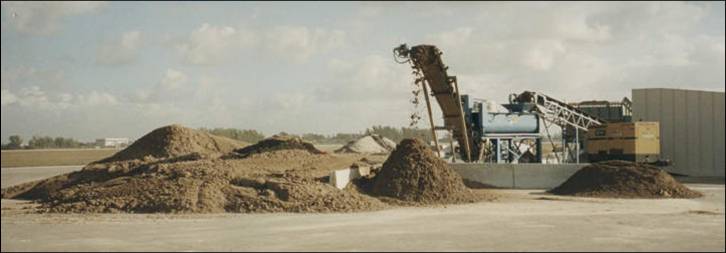Our Clients
- US Army Corps of Engineers (Superfund Project)
- King of Prussia Technical Corporation Site PRP Group (Superfund Project)
- Springfield Township Site PRP Group (Superfund Project)
- US Naval Facilities Engineering
- United States Department of Energy
- Westinghouse Hanford Company
- DuPont
- Daimler-Chrysler
- ARCADIS
- Eco Recycling Systems (France)
- City of Montreal (Canada)
- HERA AG Ambiental (Spain)
- BEFESA Gestion de Residuos Industriales (Spain)
- The Monsanto Company
- Honeywell International
- Parsons Engineering Science, Inc.
- RMI Environmental Services
- ELM Group
- Hoffman La Roche
- Langan Engineering
- Troy Chemical Company
- Penbrook Homes / Abito
Ex-Situ Chemical Oxidation of Soil & Hazardous Waste
Technology Background
ART employs two types of ex-situ soil/sediment chemical oxidation processes:
1) Saturated Soil Contacting - typical contaminant reduction efficiency in range of 50-80%
2) Soil Oxidation in Slurry Reactors - contaminant reduction greater than 90% up to 99% achievable depending on type of contamination and soil/sediment matrix.
Chemical oxidation can be potentially effective for a wide range of organic compounds found in soil and hazardous waste, including but not limited to:
- VOC's (Benzene, Toluene, BETX, Methylene Chloride and others),
- SVOC's & halogenated compounds (TCA, TCE, PCE, Vinyl Chloride, PCB, Dioxin, TNT, DNT)
- PFOA and PFOS
- DDT, HCH, Chlorinated Pesticides and others.
Sediment Oxidation Results (Treatment in Slurry Reactor followed by Stabilization)
|
Main Contaminants of Concern |
Untreated Sediment (mg/kg) |
Treated Sediment (mg/kg) |
Removal Efficiency
|
|
TCA |
940 |
3 |
> 99% |
|
TCE |
130 |
< 3.5 |
> 97% |
|
PCE |
4,300 |
41 |
> 99% |
|
Benzene |
46 |
< 0.6 |
> 99% |
|
PCB (Aroclor-1016) |
530 |
24 |
> 95% |
|
Metals |
|
|
|
|
Mercury |
0.26 mg/L TCLP |
0.0010 mg/L TCLP |
> 99% |
|
Lead |
4.7 mg/L TCLP |
< 0.040 mg/L TCLP |
> 99% |

